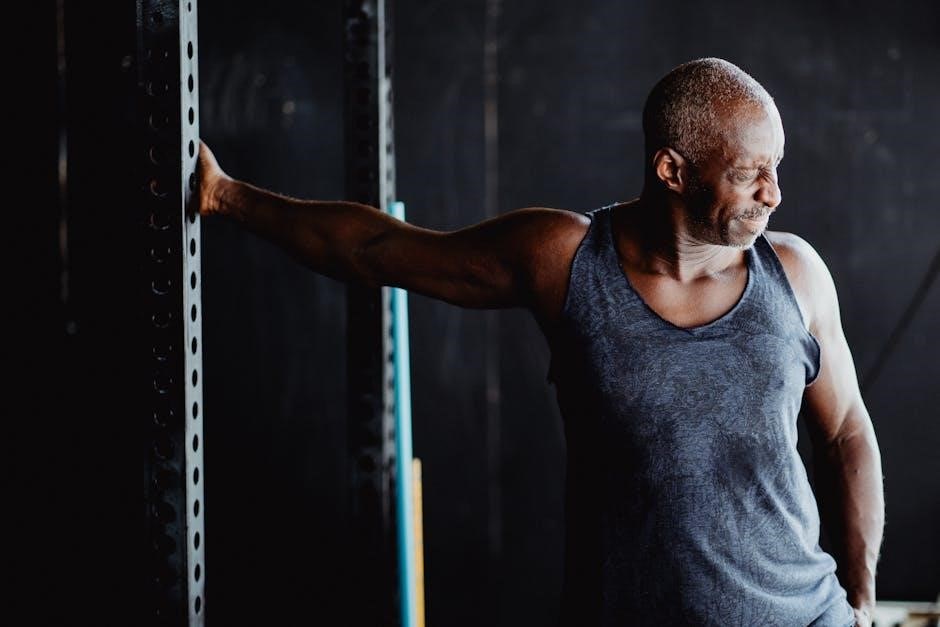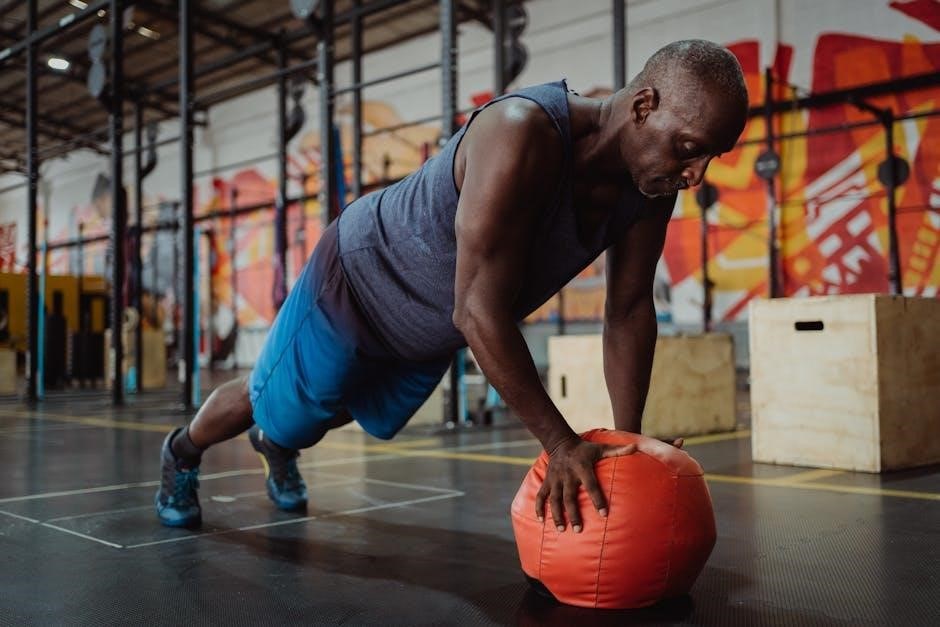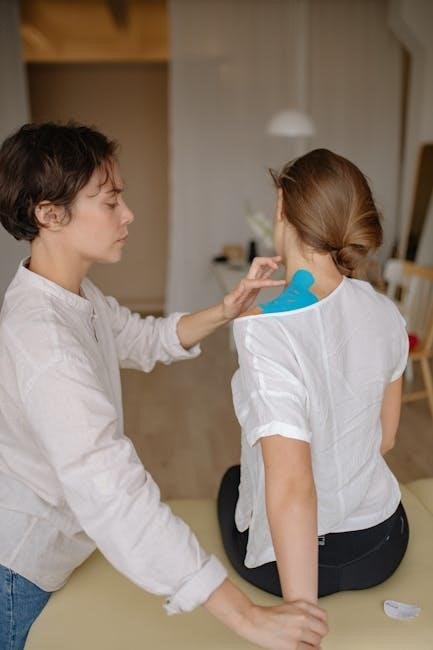Shoulder stabilisation enhances joint stability‚ preventing excessive movement and injuries. It relies on the rotator cuff and scapular stabilisers to maintain proper alignment and promote optimal shoulder function; Regular exercises improve posture‚ reduce injury risk‚ and support rehabilitation‚ making it essential for athletes and individuals with shoulder concerns.
Why Shoulder Stability Matters
Shoulder stability is crucial for preventing injuries‚ improving posture‚ and enabling proper movement. It ensures the shoulder joint operates within a safe range‚ reducing the risk of dislocations and strain. Strong stabilisation enhances athletic performance and daily activities by maintaining dynamic control. Weak shoulder stability can lead to chronic pain and limited mobility‚ making it essential to prioritise exercises that strengthen the rotator cuff and scapular muscles. Proper stabilisation protects against degenerative conditions and supports long-term joint health.
The Role of the Rotator Cuff and Scapular Stabilisers
The rotator cuff‚ comprising four muscles‚ provides dynamic stability to the shoulder joint‚ while scapular stabilisers like the trapezius and serratus muscles ensure proper scapular positioning. Together‚ they maintain joint alignment‚ prevent impingement‚ and enable smooth‚ controlled movements. Strengthening these muscles through targeted exercises enhances overall shoulder function‚ reduces injury risk‚ and supports rehabilitation. Their coordinated effort is vital for both athletic performance and everyday activities‚ ensuring optimal shoulder health and longevity.
Benefits of Shoulder Stabilisation Exercises
Shoulder stabilisation exercises prevent injuries‚ improve posture‚ and enhance athletic performance. They strengthen key muscles‚ reducing pain and promoting recovery‚ essential for overall shoulder health and functionality.
Preventing Injuries and Enhancing Posture
Shoulder stabilisation exercises play a crucial role in injury prevention by strengthening the rotator cuff and scapular stabilisers‚ which are essential for joint stability. Improved posture reduces the risk of shoulder discomfort and injuries‚ particularly in individuals with forward head syndrome or rounded shoulders. Strengthening these muscles helps maintain proper alignment‚ reducing strain on the shoulder joint during daily activities and sports; Regular practice promotes long-term shoulder health‚ minimizing the likelihood of dislocations and chronic pain‚ while enhancing overall functional movement and stability.
Improving Athletic Performance
Shoulder stabilisation exercises significantly enhance athletic performance by improving joint control and strength. Stronger rotator cuff and scapular muscles enable better throwing‚ overhead movements‚ and overall arm function. These exercises reduce shoulder fatigue‚ allowing athletes to maintain technique and endurance during prolonged activities. Enhanced stability also improves accuracy and power in sports‚ making it essential for overhead athletes. By incorporating exercises like arm circles and resistance band workouts‚ athletes can achieve better performance and reduce the risk of injuries‚ ensuring peak physical condition for their respective sports. Consistency in these exercises yields long-term benefits for athletic success.
Rehabilitation and Recovery
Shoulder stabilisation exercises play a crucial role in rehabilitation and recovery‚ particularly after injuries or surgeries. These exercises help restore joint stability‚ strengthen the rotator cuff‚ and improve scapular function. Techniques like shoulder blade squeezes and prone arm raises promote proper alignment and reduce pain. Progression to dynamic exercises‚ such as resistance band workouts‚ enhances mobility and strength. Consistency in these exercises accelerates recovery‚ prevents future injuries‚ and restores functional movement‚ making them essential for patients during the healing process to regain optimal shoulder health and function.

Key Principles of Effective Shoulder Stabilisation
Proper posture‚ controlled movements‚ and breathing techniques are essential. Exercises should focus on scapular alignment and avoid shrugging. Progression ensures stability without compromising shoulder mobility or function.
Proper Posture and Alignment
Maintaining proper posture is crucial for shoulder stability. Stand or sit with shoulders back‚ chest open‚ and spine aligned. Avoid slouching or forward head posture‚ as this strains shoulder muscles. Squeeze shoulder blades together gently to promote scapular retraction. Keep elbows slightly bent and avoid shrugging shoulders during exercises. Proper alignment ensures muscles work efficiently‚ reducing injury risk and enhancing exercise effectiveness. Consistent posture awareness supports long-term shoulder health and stability.
Controlled Movements and Breathing Techniques
Controlled movements are essential for effective shoulder stabilisation. Slow‚ deliberate actions prevent excessive joint stress‚ ensuring muscles engage properly. Practice deep‚ rhythmic breathing to maintain core stability and relaxation. Inhale deeply before movements and exhale during effort to reduce tension. Avoid holding breath‚ as it can increase muscle rigidity. Proper breathing synchronizes with movements‚ enhancing focus and reducing injury risk. This approach promotes precise muscle activation and overall shoulder stability during exercises.
Progression from Basic to Advanced Exercises
Progression in shoulder stabilisation exercises ensures gradual strength and stability development. Begin with foundational movements like shoulder blade squeezes and wall slides‚ focusing on control and proper form. As strength improves‚ introduce resistance using bands or light weights. Advanced exercises incorporate dynamic movements‚ such as plyometric actions and functional activities. Progression should be gradual‚ allowing muscles to adapt without risking injury. Each phase builds on the previous‚ ensuring a balanced and effective approach to enhancing shoulder stability and overall joint health.

Phase I: Foundational Shoulder Stabilisation Exercises
Phase I focuses on basic exercises like shoulder blade squeezes and wall slides to build foundational strength and control. These exercises are low-intensity and require proper form without weights.
Shoulder Blade Squeezes and Wall Slides
Shoulder blade squeezes involve pinching the scapulae together while maintaining proper posture‚ holding for 5-10 seconds. Wall slides require leaning against a wall‚ sliding arms upward while keeping shoulders down. These exercises strengthen scapular stabilisers and improve posture. Start with 3 sets of 10 repetitions‚ progressing as comfort allows. Focus on controlled movements to avoid compensation from other muscle groups. These foundational exercises are essential for building stability in the shoulder joint.
Prone Arm Raises and Side-Lying External Rotations
Prone arm raises involve lying face down‚ raising one arm backward with a straight elbow‚ holding for 5 seconds. Side-lying external rotations require lying on your side‚ holding a light weight‚ and rotating the arm outward. These exercises target the rotator cuff and scapular stabilisers‚ enhancing strength and stability. Perform 3 sets of 10-15 repetitions on each side‚ ensuring controlled movements. Progress gradually by increasing resistance or range of motion as shoulder strength improves. These exercises are crucial for restoring functional shoulder stability and preventing injuries.
Phase II: Dynamic and Resistance-Based Exercises
Phase II introduces dynamic movements and resistance‚ such as arm circles and resistance band workouts‚ to enhance shoulder strength and stability progressively. These exercises improve joint control and resilience‚ preparing the shoulder for more demanding activities while reducing injury risk. They build on foundational stability‚ incorporating controlled movements to strengthen the rotator cuff and scapular muscles effectively.
Arm Circles and Resistance Band Workouts
Arm circles and resistance band workouts are essential for improving shoulder stability and strength. Start with small arm circles‚ gradually increasing size‚ to enhance joint mobility and control. Resistance bands add tension‚ strengthening the rotator cuff and scapular muscles. These exercises promote proper alignment‚ reducing injury risk. Perform arm circles with arms extended‚ progressing to resisted movements. Resistance bands can be used for rowing‚ external rotations‚ and presses‚ targeting dynamic stability. Consistent practice improves joint resilience and endurance‚ preparing shoulders for daily activities and sports.
Standing Rows and Front Raises
Standing rows and front raises are dynamic exercises that strengthen the shoulder muscles and improve stability. For rows‚ hold a resistance band or light weights‚ bend knees slightly‚ and pull elbows back‚ squeezing shoulder blades. Front raises involve lifting weights or bands forward to shoulder height‚ maintaining controlled movements. These exercises target the rhomboids‚ deltoids‚ and rotator cuff‚ enhancing posture and reducing injury risk. Perform with proper form‚ engaging core and avoiding shrugging. Progress gradually to challenge muscles effectively‚ promoting overall shoulder resilience and functional strength.

Phase III: Advanced Stabilisation Techniques
Advanced techniques involve weighted exercises and plyometric movements to enhance strength and resilience. These dynamic drills challenge the shoulder‚ promoting stability and functional application in real-world scenarios.
Weighted Exercises and Plyometric Movements
Weighted exercises and plyometric movements are integral to advanced shoulder stabilisation‚ enhancing strength and resilience. These techniques add resistance and dynamic challenges‚ strengthening the rotator cuff and scapular stabilisers. Plyometric movements‚ such as medicine ball throws‚ improve explosive power and functional stability. Weighted exercises‚ like dumbbell presses‚ build endurance and muscle control. Together‚ they prepare the shoulder for high-demand activities‚ ensuring stability and reducing injury risk in dynamic and real-world scenarios.
Functional Activities for Real-World Application
Functional activities bridge the gap between stabilisation exercises and real-world movements‚ enhancing practical shoulder use. Wall slides and prone arm raises simulate daily tasks‚ improving control and strength. Such exercises prepare the shoulders for activities like carrying groceries or reaching overhead‚ making them indispensable for both daily life and athletic performance. Integrating these movements ensures the shoulders are ready for real-world demands‚ reducing injury risk and boosting overall functionality. These exercises are vital for applying stabilisation in dynamic‚ real-life scenarios.

Incorporating Shoulder Stabilisation into Your Routine
Consistency is key to effective shoulder stabilisation. Aim for 3-4 sessions weekly‚ focusing on controlled movements and gradual progression. Proper form ensures long-term benefits and injury prevention‚ making these exercises a sustainable part of your daily or athletic routine. Regular practice enhances strength‚ flexibility‚ and overall shoulder health‚ promoting stability in both daily activities and sports performance. Stability exercises should be tailored to individual goals and progression levels for optimal results. This structured approach ensures continuous improvement and lasting shoulder stability.
Frequency‚ Sets‚ and Repetitions
For effective shoulder stabilisation‚ exercises should be performed 3-4 times weekly. Start with 2-3 sets of 10-15 repetitions for foundational movements like shoulder blade squeezes and arm raises. Progress gradually by increasing repetitions or resistance as strength improves. Consistency is crucial to building stability and preventing fatigue. Advanced exercises‚ such as weighted movements‚ may require fewer repetitions but higher focus on form. Always prioritize proper technique and adjust routines based on individual progress and goals‚ ensuring a balanced approach to shoulder health and functionality.
Progression and Modification of Exercises
Begin with basic exercises like shoulder blade squeezes and arm raises‚ progressing to resistance bands or light weights as strength improves. Modify movements to suit fitness levels by adjusting resistance or range of motion. For advanced individuals‚ incorporate dynamic exercises such as plyometric movements or weighted activities. Always prioritize proper form to prevent injury and enhance effectiveness. Tailor exercises to individual goals‚ gradually increasing intensity to avoid plateaus and ensure continuous improvement in shoulder stability and overall function.
Consistent practice of shoulder stabilisation exercises ensures long-term joint health and injury prevention. Proper form and progressive overload are key to achieving optimal shoulder functionality and durability over time.
The Importance of Consistency and Proper Form
Consistency and proper form are crucial for effective shoulder stabilisation. Performing exercises regularly ensures lasting improvements in joint stability and strength. Proper form prevents injuries and enhances muscle engagement‚ particularly in the rotator cuff and scapular stabilisers. Avoiding poor posture and maintaining controlled movements are essential for optimal results. Breathing techniques and gradual progression also contribute to safe and effective practice. Over time‚ these habits promote long-term shoulder health and functionality‚ reducing the risk of future issues.
Long-Term Benefits for Shoulder Health
Regular shoulder stabilisation exercises offer long-term benefits‚ including enhanced joint stability‚ reduced injury risk‚ and improved overall shoulder functionality. Strengthening the rotator cuff and scapular muscles promotes better posture and movement patterns‚ reducing strain on the shoulder. Over time‚ these exercises can prevent chronic pain‚ improve athletic performance‚ and support daily activities. Consistent practice fosters resilience‚ ensuring shoulders remain healthy and robust‚ even with aging or increased physical demands. This investment in shoulder health pays dividends for years‚ maintaining mobility and quality of life.



0 Comments